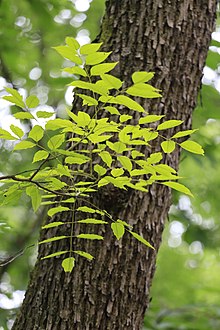|
Choerospondias
Choerospondias axillaris, known in English as the Nepali hog plum, is a tree in the family Anacardiaceae. It is the sole species in genus Choerospondias. It is native to the Himalayas, Indochina, southern and north-central China, Taiwan, and Japan.[1] It is a common fruit in Nepal and Bhutan, called lapsi and aamli[citation needed] in the Nepali-speaking community. Its fruit is about 3 centimeters long and has a soft whitish sour flesh and green to yellow skin. The fruit is made into pickles, fruit tarts, and sour, spicy candy. The tree has long been cultivated for its fruit.[2] The fruit is nutritious and has a price comparable to the mandarin orange on the Nepalese market.[2] This is a deciduous tree growing up to 20 meters tall. The smaller branches are purple-brown in color. The compound leaves are up to 40 cm (16 in) long and divided into 3 to 6 papery oval leaflets each up to 12 cm × 4.5 cm (4.7 in × 1.8 in).[3] The tree is dioecious, with male and female trees producing different types of inflorescence.[2] Male flowers occur in long clusters and have curving, brown-veined petals about 3 millimeters long. Female flowers are solitary in leaf axils at the tips of branches. They are larger than the male flowers and yield the edible drupe. The fallen fruits are consumed and dispersed by sambar and barking deer.[4][5] The fruit is also used in religious ceremonies as an offering.[6] Besides fruit, the tree yields valuable wood and hard seeds which are burned for fuel, and has parts used medicinally in Vietnam and Tibet.[2] Catechin-7-O-glucoside can be found in the stem barks of C. axillaris.[7] GalleryReferences
This article incorporates text from a publication now in the public domain: Wood, James, ed. (1907). The Nuttall Encyclopædia. London and New York: Frederick Warne. |
||||||||||||||||||||||||||||||||||||||



